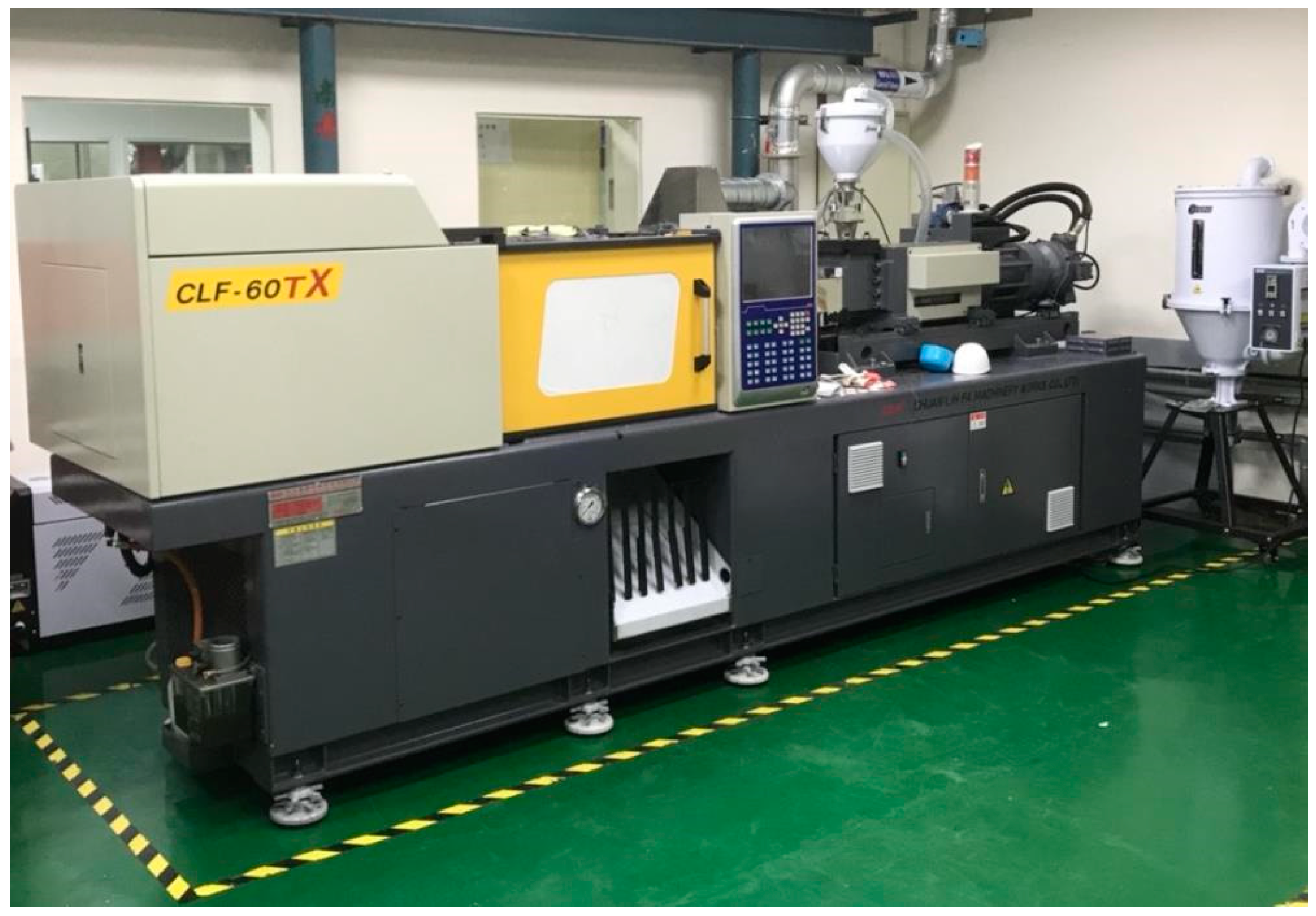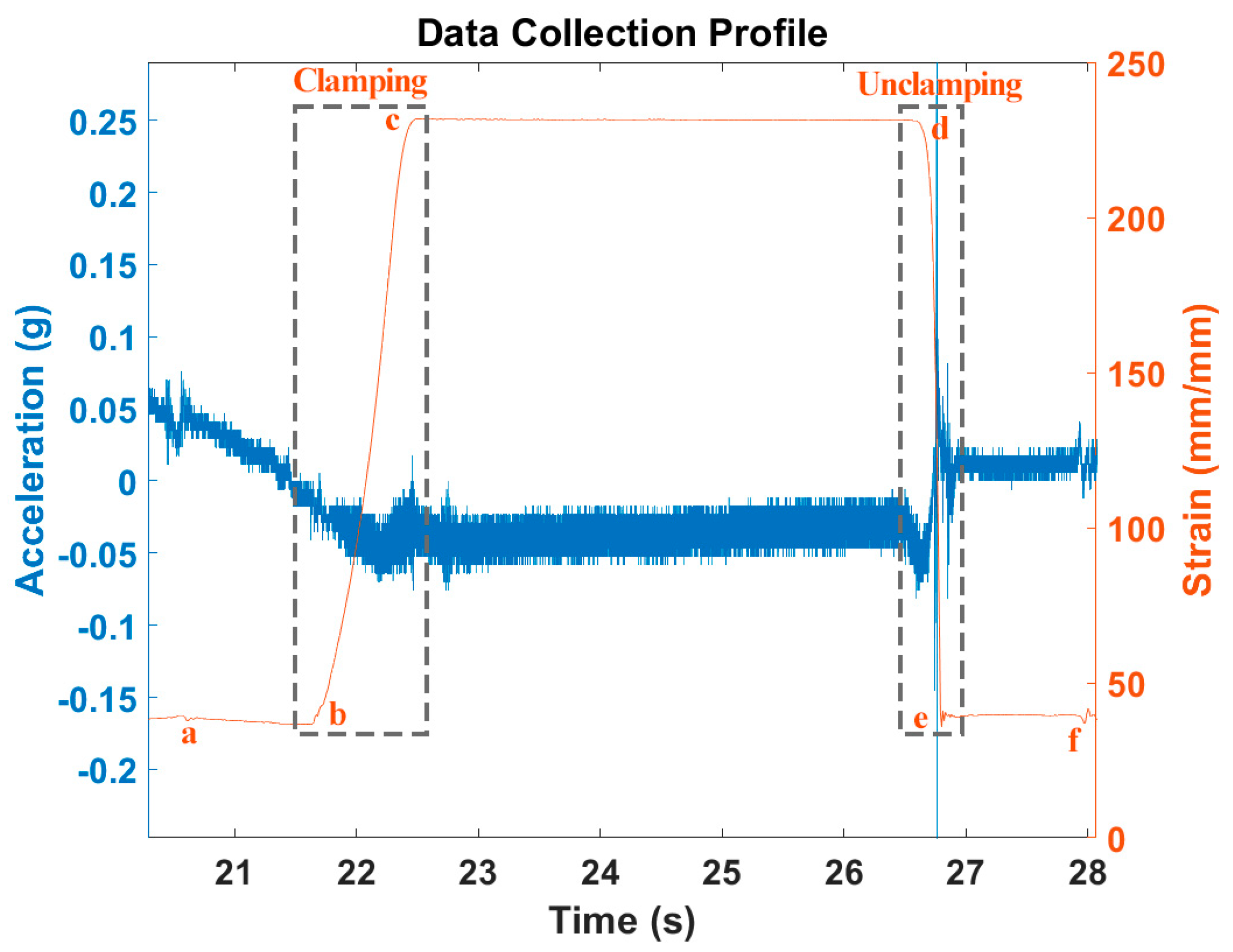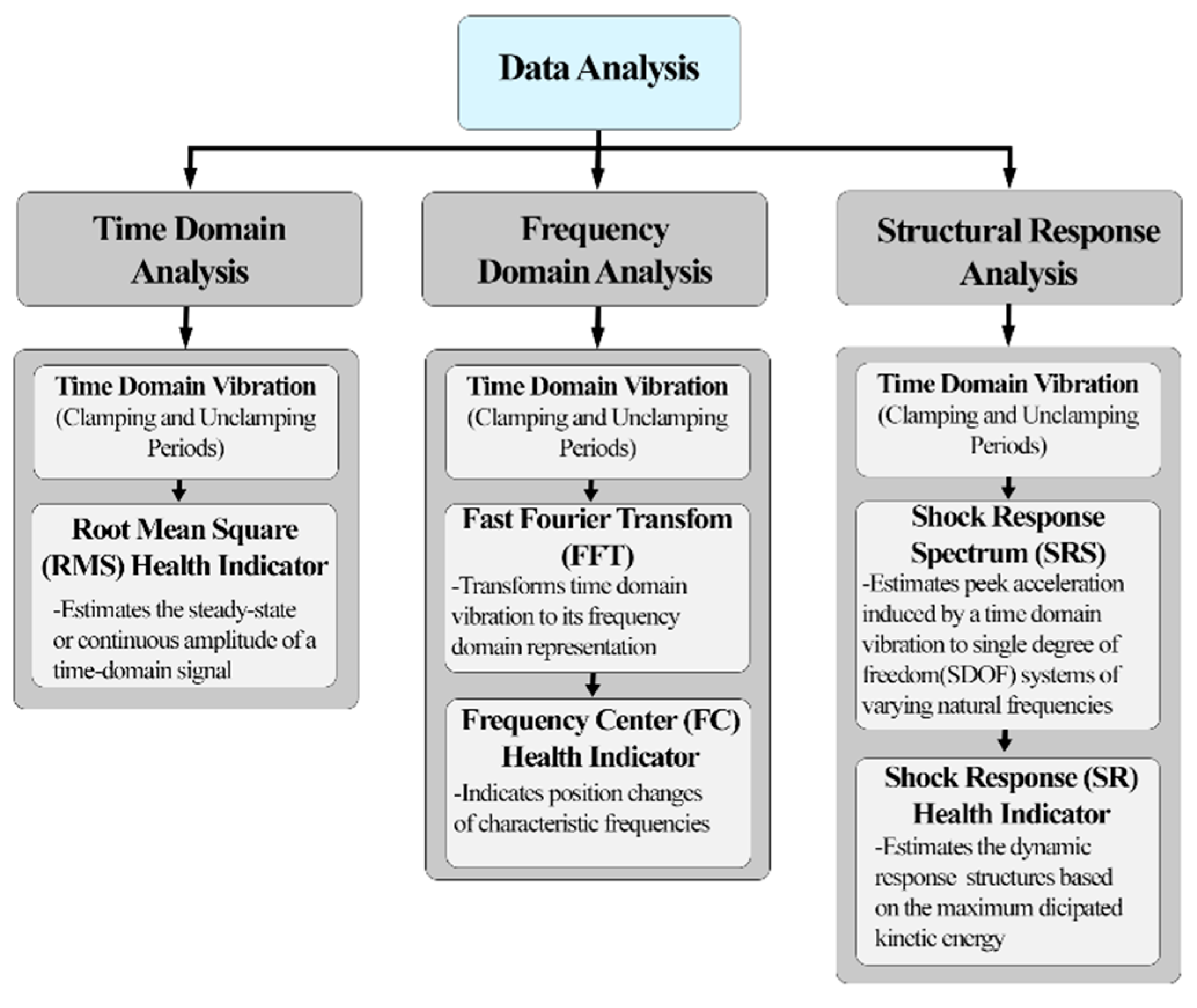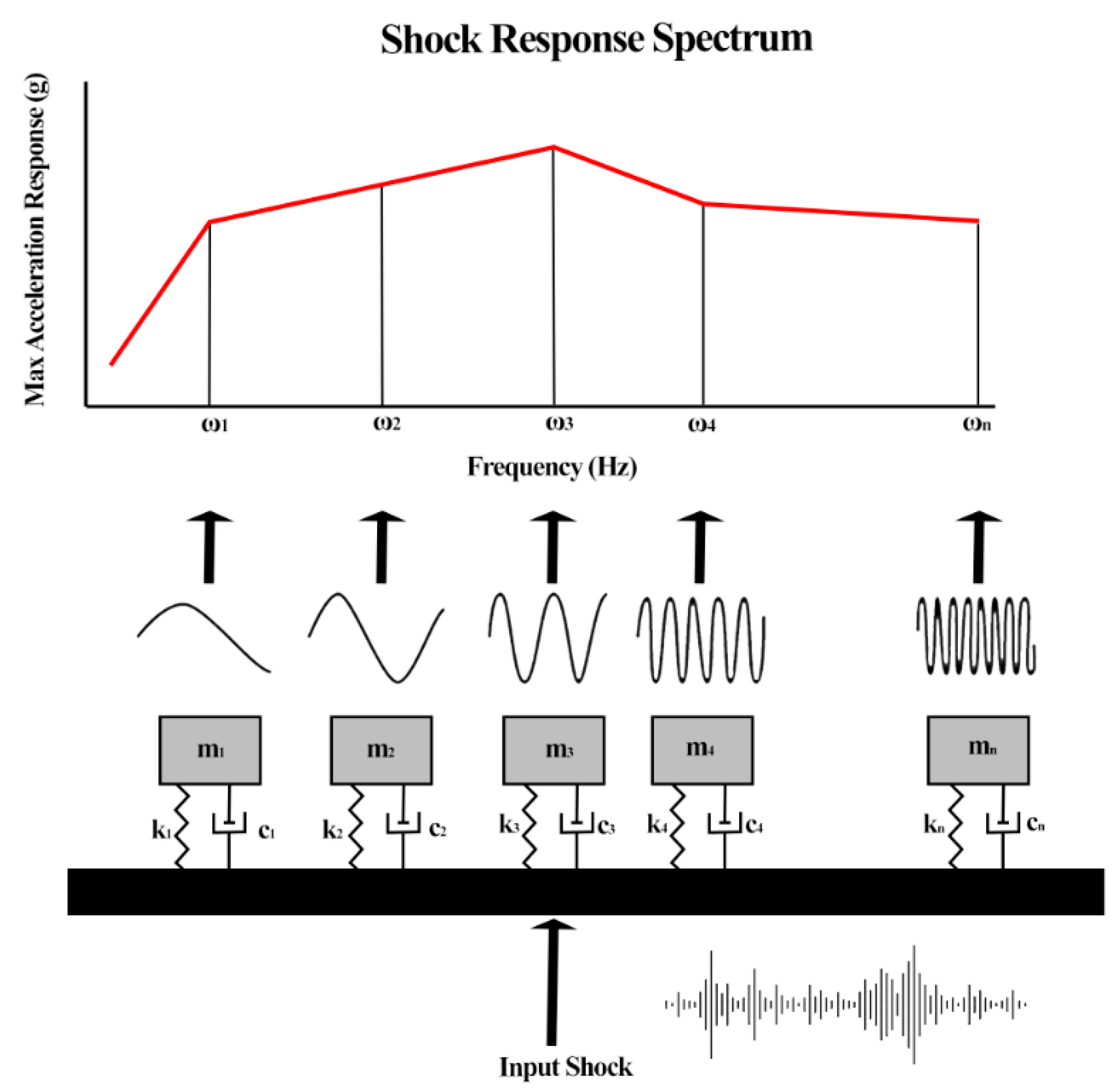Development of a Reliable Vibration Based Health Indicator for Monitoring the Lubricating Condition of the Toggle Clamping System of a Plastic Injection Molding Machine
Abstract
1. Introduction
2. Materials and Methods
2.1. Experimental Instruments
2.1.1. Injection Molding Machine
2.1.2. Data Acquisition System
2.2. Methodology
2.2.1. Experimental Setup
- A PCB Piezotronics accelerometer (Model:352A24) of sensitivity 100 mV/g and a measurement range of ±50 g was mounted onto the stationary pin of the toggle clamping system as shown in Figure 2.
- A strain gauge was mounted across the tie bar of the injection molding machine.
- The accelerometer and strain gauge were connected to an IMC CRONOSflex DAQ.
- The vibration and strain data were sampled at a rate of 50 kHz and 100 Hz, respectively.
- The logged data was finally transferred and stored onto a PC via an RJ45 cable for further data analysis.
2.2.2. Experimental Procedures
- The clamping force of the injection molding machine was set to 240 kPa. The toggle clamping system was completely lubricated for 40 s with BETTA anti-stick, extreme pressure oil.
- The toggle was clamped and unclamped repeatedly until a screeching sound was detected by the experienced machine operator.
- At the onset of the screeching sound, the toggle was completely re-lubricated for another 40 s while allowed to continue its opening and closing motion.
- The re-lubrication points were selected to be at cycles of 150, 330, and 530. The toggle clamping system was monitored over a total of 560 cycles.
2.2.3. Data Acquisition
2.2.4. Data Treatment
2.2.5. Data Analysis
- The vibration signals generated during the clamping an unclamping period for each of the 560 cycles were extracted.
- The extracted clamping and unclamping vibrations were analyzed using three classes of vibration analysis techniques. These three classes include (a) time domain analyses, (b) frequency domain analysis, and (c) structural response analysis.
- Health indicators (HI) representative of the instantaneous lubricating condition of the toggle clamping system were derived from all three classes of vibration analysis techniques.
- Figure 4, below, shows a flowchart detailing the data analysis conducted in this study.
3. Basic Theory
3.1. Vibration Analysis Techniques Used as Condition Indicators
3.2. Time Domain Analysis
3.2.1. Description
3.2.2. Root Mean Square
| Health index derived using RMS algorithm | |
| the RMS value of dataset | |
| the ith member of dataset | |
| N | the number of points in dataset |
3.3. Frequency Domain Analysis
3.3.1. Description
3.3.2. Fast Fourier Transform (FFT)
3.4. Structural Response Analysis
3.4.1. Description
3.4.2. Shock Response Spectrum (SRS)
| Spring constant of each SDOF system | |
| Absolute acceleration of each SDOF system | |
| Input shock | |
| Damping ratio of each SDOF system | |
| N | Number of SDOF systems |
| Oscillation frequency |
4. Results and Discussion
5. Conclusions
6. Patents
Author Contributions
Funding
Institutional Review Board Statement
Informed Consent Statement
Data Availability Statement
Acknowledgments
Conflicts of Interest
References
- He, W.; Zhang, Y.F.; Lee, K.S.; Liu, T.I. Development of a Fuzzy-Neuro System for Parameter Resetting of Injection Molding. J. Manuf. Sci. Eng. 2000, 123, 110–118. [Google Scholar] [CrossRef]
- Tang, S.H.; Tan, Y.J.; Sapuan, S.M.; Sulaiman, S.; Ismail, N.; Samin, R. The Use of Taguchi Method in the Design of Plastic Injection Mould for Reducing Warpage. J. Mater. Process. Technol. 2007, 182, 418–426. [Google Scholar] [CrossRef]
- López, A.; Aisa, J.; Martinez, A.; Mercado, D. Injection Moulding Parameters Influence on Weight Quality of Complex Parts by Means of Doe Application: Case Study. Measurement 2016, 90, 349–356. [Google Scholar] [CrossRef]
- Ajay Shevale, R.S. Design and Analysis of Shutter in Injection Molding Machine. Int. J. Recent Technol. Mech. Electr. Eng. 2018, 5, 5. [Google Scholar]
- Sheikh, M. Study & Review of Design and Manufacturing of Vertical Injection Moulding Machine Prototype Parts. Available online: https://www.ijtre.com/images/scripts/16196.pdf (accessed on 28 November 2021).
- Chen, W.-C.; Tai, P.-H.; Wang, M.-W.; Deng, W.-J.; Chen, C.-T. A Neural Network-Based Approach for Dynamic Quality Prediction in a Plastic Injection Molding Process. Expert Syst. Appl. 2008, 35, 843–849. [Google Scholar] [CrossRef]
- Kumar, C.S.; Srikanth, S.; Das, S.K. Analysis of Premature Failure of a Tie Bar in an Injection Molding Machine. Eng. Fail. Anal. 2006, 13, 1246–1259. [Google Scholar]
- Sander, D.E.; Allmaier, H.; Priebsch, H.H.; Witt, M.; Skiadas, A. Simulation of Journal Bearing Friction in Severe Mixed Lubrication–Validation and Effect of Surface Smoothing Due to Running-In. Tribol. Int. 2016, 96, 173–183. [Google Scholar] [CrossRef]
- Plastic Injection Moulding Lubricants; Gleaner: Milnefield Ave, Elgin, UK, 2019.
- Lin, W.-Y.; Hsiao, K.M. Investigation of the Friction Effect at Pin Joints for the Five-Point Double-Toggle Clamping Mechanisms of Injection Molding Machines. Int. J. Mech. Sci. 2003, 45, 1913–1927. [Google Scholar] [CrossRef]
- Lin, W.Y.; Hsiao, K.M. Study on Improvements of the Five-Point Double-Toggle Mould Clamping Mechanism. Proc. Inst. Mech. Eng. Part C J. Mech. Eng. Sci. 2004, 218, 761–774. [Google Scholar] [CrossRef]
- Huang, M.-S.; Lin, T.-Y.; Fung, R.-F. Key Design Parameters and Optimal Design of a Five-Point Double-Toggle Clamping Mechanism. Appl. Math. Model. 2011, 35, 4304–4320. [Google Scholar] [CrossRef]
- Dietl, P.; Wensing, J.; van Nijen, G.C. Rolling Bearing Damping for Dynamic Analysis of Multi-Body Systems—Experimental and Theoretical Results. Proc. Inst. Mech. Eng. Part K J. Multi-Body Dyn. 2000, 214, 33–43. [Google Scholar] [CrossRef]
- Ankouni, M.; Lubrecht, A.; Velex, P. Modelling of Damping in Lubricated Line Contacts—Applications to Spur Gear Dynamic Simulations. Proc. Inst. Mech. Eng. Part C J. Mech. Eng. Sci. 2016, 230, 1222–1232. [Google Scholar] [CrossRef]
- Xiao, F.; Tian, C.; Wait, I.; Yang, Z.; Still, B.; Chen, G.S. Condition Monitoring and Vibration Analysis of Wind Turbine. Adv. Mech. Eng. 2014, 12, 1687814020913782. [Google Scholar] [CrossRef]
- Shah, B.A.; Vakharia, D.P. Online Condition Monitoring for Detection of Crack in the Shaft Using Vibration Analysis Method. Ind. Lubr. Tribol. 2018, 70, 1193–1200. [Google Scholar] [CrossRef]
- Vishwakarma, M.; Purohit, R.; Harshlata, V.; Rajput, P. Vibration Analysis & Condition Monitoring for Rotating Machines: A Review. Mater. Today Proc. 2017, 4, 2659–2664. [Google Scholar]
- Caesarendra, W.; Tjahjowidodo, T. A Review of Feature Extraction Methods in Vibration-Based Condition Monitoring and Its Application for Degradation Trend Estimation of Low-Speed Slew Bearing. Machines 2017, 5, 21. [Google Scholar] [CrossRef]
- Fu, T.-C. A Review on Time Series Data Mining. Eng. Appl. Artif. Intell. 2011, 24, 164–181. [Google Scholar] [CrossRef]
- Mohd Ghazali, M.H.; Rahiman, W. Vibration Analysis for Machine Monitoring and Diagnosis: A Systematic Review. Shock Vib. 2021, 2021, 9469318. [Google Scholar] [CrossRef]
- Igba, J.; Alemzadeh, K.; Durugbo, C.; Eiriksson, E.T. Analysing Rms and Peak Values of Vibration Signals for Condition Monitoring of Wind Turbine Gearboxes. Renew. Energy 2016, 91, 90–106. [Google Scholar] [CrossRef]
- Ahmed, H.; Nandi, A. Time-Frequency Domain Analysis. In Condition Monitoring With Vibration Signals; Wiley: Hoboken, NJ, USA, 2019; Volume 5, pp. 79–114. [Google Scholar]
- Feng, Z.; Liang, M.; Chu, F. Recent Advances in Time–Frequency Analysis Methods for Machinery Fault Diagnosis: A Review with Application Examples. Mech. Syst. Signal Process. 2013, 38, 165–205. [Google Scholar] [CrossRef]
- Yan, R.; Gao, R.X.; Chen, X. Wavelets for Fault Diagnosis of Rotary Machines: A Review with Applications. Signal Process. 2014, 96, 1–15. [Google Scholar] [CrossRef]
- Khadersab, A.; Shivakumar, S. Vibration Analysis Techniques for Rotating Machinery and Its Effect on Bearing Faults. Procedia Manuf. 2018, 20, 247–252. [Google Scholar] [CrossRef]
- Bergland, G.D. A Guided Tour of the Fast Fourier Transform. IEEE Spectr. 1969, 6, 41–52. [Google Scholar] [CrossRef]
- Cochran, W.T.; Cooley, J.W.; Favin, D.L.; HelmsH, D.; Kaenel, R.A.; Lang, W.W.; Maling, G.C.; Nelson, D.E.; Rader, C.M.; Welch, P.D. What Is the Fast Fourier Transform? Proc. IEEE 1967, 55, 1664–1674. [Google Scholar] [CrossRef]
- Yang, B.S.; Widodo, A. Introduction of Intelligent Machine Fault Diagnosis and Prognosis; Nova Science Publishers: New York, NY, USA, 2009; pp. 1–351. [Google Scholar]
- Alexander, J. The Shock Response Spectrum—A Primer. Sound Vib. 2009, 43, 6–14. [Google Scholar]
- Gaberson, H. Shock Severity Estimation. Sound Vib. 2012, 46, 12–20. [Google Scholar]
- Irvine, T. An Introduction to the Shock Response Spectrum, Rev S. Available online: https://www.vibrationdata.com/tutorials2/srs_intr.pdf (accessed on 28 November 2021).
- Ando, J.; Yamaguchi, T.; Hokkirigawa, K. Improvement in Mixed Lubrication Characteristics of Electromagnetic Clutch Coated with Dlc-Si Film by Controlling Surface Roughness and Providing Micro-Groove. Toraibarojisuto/J. Jpn. Soc. Tribol. 2013, 58, 685–694. [Google Scholar] [CrossRef][Green Version]
- Chen, G. Fundamentals of Contact Mechanics and Friction. In Handbook of Friction-Vibration Interactions; Woodhead Publishing: Swaston, Cambridge, UK, 2014; Volume 3, pp. 71–152. [Google Scholar]
- Li, Q.; Dimaki, A.; Popov, M.; Psakhie, S.G.; Popov, V.L. Kinetics of the Coefficient of Friction of Elastomers. Sci. Rep. 2014, 4, 5795. [Google Scholar] [CrossRef]
- Wu, T.; Mao, J.; Dong, G.; Xu, H.; Xie, Y. Journal Bearing Wear Monitoring Via on-Line Visual Ferrography. Adv. Mater. Res. 2008, 44–46, 189–194. [Google Scholar] [CrossRef]








Publisher’s Note: MDPI stays neutral with regard to jurisdictional claims in published maps and institutional affiliations. |
© 2021 by the authors. Licensee MDPI, Basel, Switzerland. This article is an open access article distributed under the terms and conditions of the Creative Commons Attribution (CC BY) license (https://creativecommons.org/licenses/by/4.0/).
Share and Cite
Morgan, W.J.; Chu, H.-Y. Development of a Reliable Vibration Based Health Indicator for Monitoring the Lubricating Condition of the Toggle Clamping System of a Plastic Injection Molding Machine. Appl. Sci. 2022, 12, 196. https://doi.org/10.3390/app12010196
Morgan WJ, Chu H-Y. Development of a Reliable Vibration Based Health Indicator for Monitoring the Lubricating Condition of the Toggle Clamping System of a Plastic Injection Molding Machine. Applied Sciences. 2022; 12(1):196. https://doi.org/10.3390/app12010196
Chicago/Turabian StyleMorgan, Wani J., and Hsiao-Yeh Chu. 2022. "Development of a Reliable Vibration Based Health Indicator for Monitoring the Lubricating Condition of the Toggle Clamping System of a Plastic Injection Molding Machine" Applied Sciences 12, no. 1: 196. https://doi.org/10.3390/app12010196
APA StyleMorgan, W. J., & Chu, H.-Y. (2022). Development of a Reliable Vibration Based Health Indicator for Monitoring the Lubricating Condition of the Toggle Clamping System of a Plastic Injection Molding Machine. Applied Sciences, 12(1), 196. https://doi.org/10.3390/app12010196





